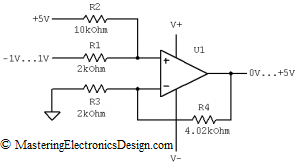Bipolar to Unipolar Converter Example
The calculator solves the summing amplifier resistors based on the input and output voltage range requirements. It is a great tool to design a bipolar to unipolar converter, as an example and other circuits.
Enter the input range, Vin1 to Vin2, the output range, Vout1 to Vout2 and a reference voltage Vref which helps in adjusting the common-mode level of the amplifier. Since the 2-input summing amplifier has 4 resistors, you need to choose two resistors, R1 and R3, and calculate R2 and R4. For more details about this calculator read How to Design a Summing Amplifier Calculator.








